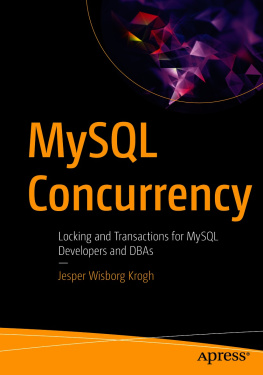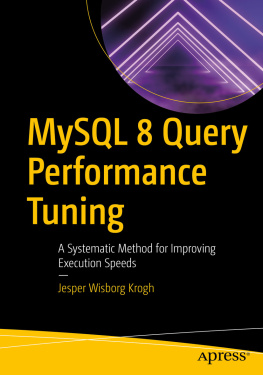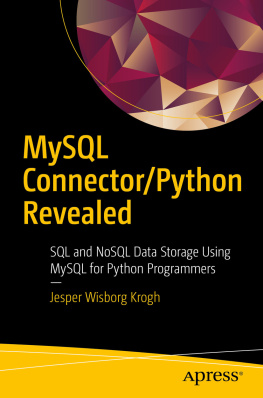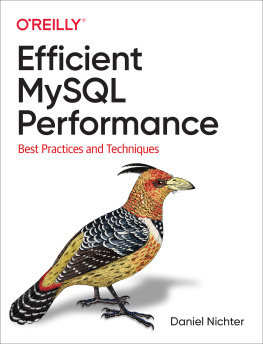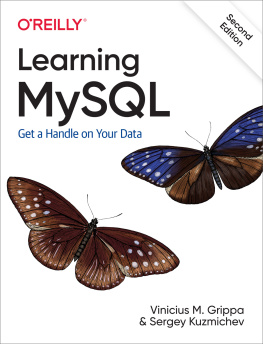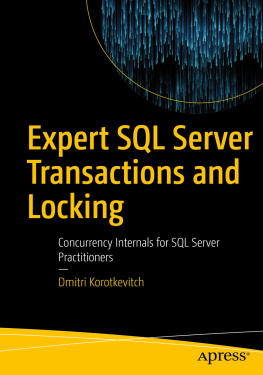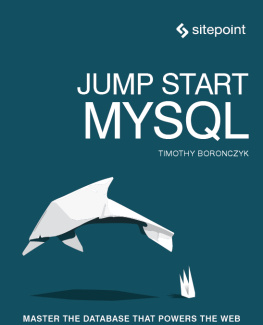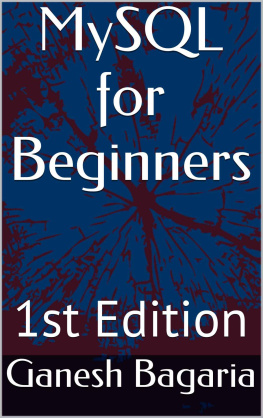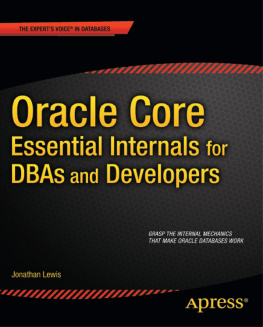Jesper Wisborg Krogh - My SQL Concurrency: Locking and Transactions for MySQL Developers and DBAs
Here you can read online Jesper Wisborg Krogh - My SQL Concurrency: Locking and Transactions for MySQL Developers and DBAs full text of the book (entire story) in english for free. Download pdf and epub, get meaning, cover and reviews about this ebook. publisher: Apress, genre: Computer. Description of the work, (preface) as well as reviews are available. Best literature library LitArk.com created for fans of good reading and offers a wide selection of genres:
Romance novel
Science fiction
Adventure
Detective
Science
History
Home and family
Prose
Art
Politics
Computer
Non-fiction
Religion
Business
Children
Humor
Choose a favorite category and find really read worthwhile books. Enjoy immersion in the world of imagination, feel the emotions of the characters or learn something new for yourself, make an fascinating discovery.
- Book:My SQL Concurrency: Locking and Transactions for MySQL Developers and DBAs
- Author:
- Publisher:Apress
- Genre:
- Rating:3 / 5
- Favourites:Add to favourites
- Your mark:
- 60
- 1
- 2
- 3
- 4
- 5
My SQL Concurrency: Locking and Transactions for MySQL Developers and DBAs: summary, description and annotation
We offer to read an annotation, description, summary or preface (depends on what the author of the book "My SQL Concurrency: Locking and Transactions for MySQL Developers and DBAs" wrote himself). If you haven't found the necessary information about the book — write in the comments, we will try to find it.
My SQL Concurrency: Locking and Transactions for MySQL Developers and DBAs — read online for free the complete book (whole text) full work
Below is the text of the book, divided by pages. System saving the place of the last page read, allows you to conveniently read the book "My SQL Concurrency: Locking and Transactions for MySQL Developers and DBAs" online for free, without having to search again every time where you left off. Put a bookmark, and you can go to the page where you finished reading at any time.
Font size:
Interval:
Bookmark:
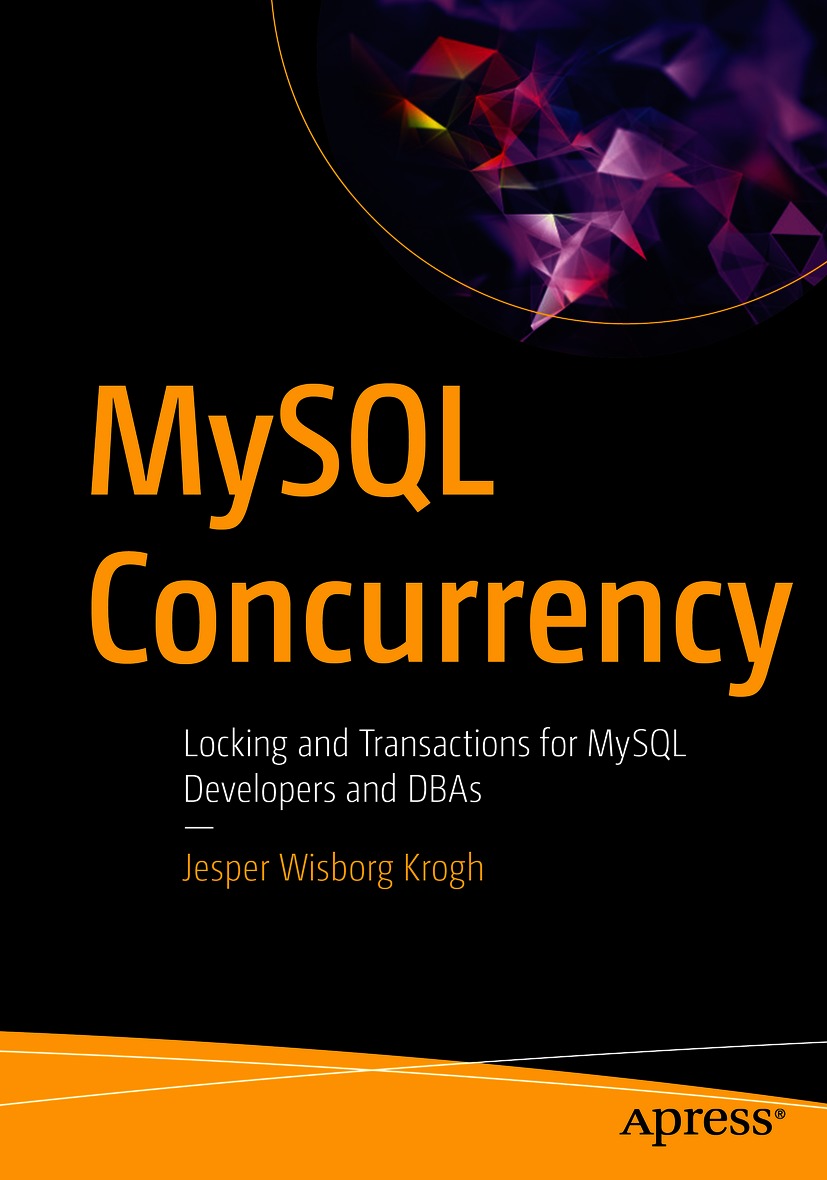

Any source code or other supplementary material referenced by the author in this book is available to readers on GitHub via the books product page, located at www.apress.com/9781484266519 . For more detailed information, please visit http://www.apress.com/source-code .
To my wife Ann-Margrete Thanks for the patience and support.
When working with databases, locks and transactions are some of the most difficult and misunderstood topics. This book aims at improving your understanding of these two concepts, how they work, how you can investigate them, and how you can improve your workload, so it works the best with them. This is achieved through a combination of discussing monitoring, the lock and transaction theory, and a series of case studies.
MySQL is famous for its support for storage engines. However, this book exclusively covers the InnoDB storage engine, and only MySQL 8 is considered. That said, most of the discussion also applies to older versions of MySQL, and in general, it is mentioned when a feature is new in MySQL 8 or that MySQL 8 has a different behavior compared to older versions.
The book has been written for developers and database administrators who have experience working with MySQL and want to expand their knowledge of how locks and transactions work in the realm of MySQL concurrency.
I have tried to add as many examples and outputs from examples as possible. Some of the examples are quite short, some are quite long. In either case, I hope you are able to follow them and reproduce the effect or result demonstrated. At the same time, please do bear in mind that by nature there is often randomness involved, and the exact outcome of the examples may depend on how the tables and data have been used prior to the example. In other words, you may get different results even if you did everything right. This particularly applies to numbers that relate to lock ids, memory locations, mutexes/semaphores, timings, and the like.
Examples that are long or produce outputs that are either long or wide have been added to this books GitHub repository. This includes some of the figures that may be hard to read with the image size that the page format allows.
The link to the repository can be found from the books home page at www.apress.com/gp/book/9781484266519 . It can also be found directly at www.github.com/Apress/mysql-concurrency .
To make it easier to reproduce the examples and to provide example queries that can be used to examine the issue the test demonstrates, a module written in Python for use in MySQL Shell is also included in the books GitHub repository. The basic installation and usage instructions are covered in Chapter and the full documentation in Appendix B.
The GitHub repository will also be the home of the errata for the book once that is created. I will use the errata not only to communicate errors in the book but also to provide updates when bug fixes and new features in MySQL 8 cause changes to book content. If necessary, I will also update the examples in the repository to reflect the behavior in the newer releases. For these reasons, I recommend that you keep an eye on the repository.
I have attempted to keep each chapter relatively self-contained with the aim that you can use the book as a reference book. The drawback of this choice is that there is some duplication of information from time to time. This is particularly evident in the case studies that repeat some of the information discussed in earlier chapters. This was a deliberate choice, and I hope it helps you to reduce the amount of page flipping to find the information you need.
Chapter, Introduction: This introductory chapter covers some high-level concepts as well as introduces the MySQL Shell module for reproducing the example and the test data used in this book.
Chapter, Monitoring Locks: This chapter covers how you can monitor locks using the Performance Schema, the sys schema, status counters, and InnoDB metrics. There is also information on how to use the InnoDB lock monitor and the deadlock information in the InnoDB monitor and how to obtain information about mutex and semaphore contention.
Chapter, Monitoring InnoDB Transactions: This chapter primarily shows how you can use the information_schema.INNODB_TRX view to investigate InnoDB transaction. The transaction list in the InnoDB monitor and transaction-related InnoDB metrics are also covered.
Chapter, Transactions in the Performance Schema: This chapter continues where the previous stopped by going through the transaction information in the Performance Schema and how you can find the statements for a transaction.
Chapter, Lock Access Levels:
Font size:
Interval:
Bookmark:
Similar books «My SQL Concurrency: Locking and Transactions for MySQL Developers and DBAs»
Look at similar books to My SQL Concurrency: Locking and Transactions for MySQL Developers and DBAs. We have selected literature similar in name and meaning in the hope of providing readers with more options to find new, interesting, not yet read works.
Discussion, reviews of the book My SQL Concurrency: Locking and Transactions for MySQL Developers and DBAs and just readers' own opinions. Leave your comments, write what you think about the work, its meaning or the main characters. Specify what exactly you liked and what you didn't like, and why you think so.

